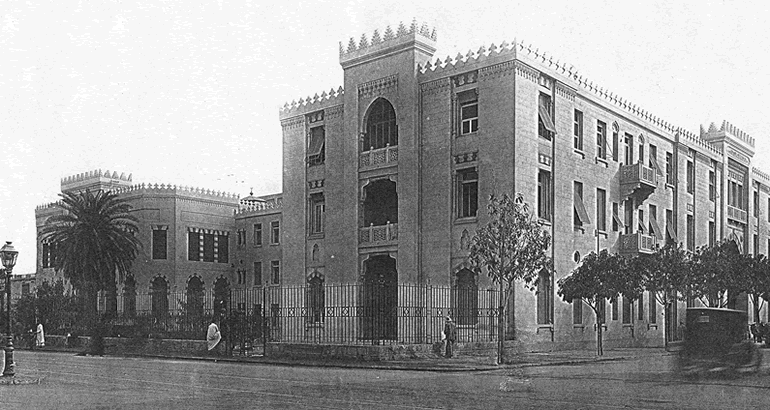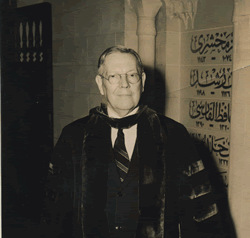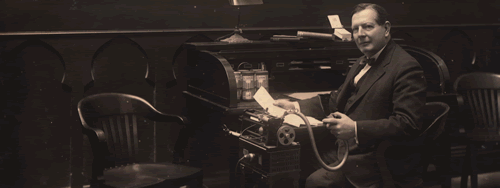
AUC's Founding
The dream and vision of the
university’s first president
established the foundation
for AUC as it is today
By Jeffrey Bellis
Photographs from the University Archives, Rare Books and Special Collections Library
 Charles Watson was born and raised in Cairo,
leaving for the United
Charles Watson was born and raised in Cairo,
leaving for the United
States once he reached
adulthood to study at the Lawrenceville School
and Princeton University. After teaching in different
prestigious universities including Princeton, he spent
many years in various positions affiliated with the United
Presbyterian Church, first as a pastor and later as secretary
of the Board of Foreign Missions. As a college student,
Watson had often dreamed of launching an American
university in Cairo, and as part of his work, he made
separate trips to Cairo in 1912, 1915 and 1917 to
evaluate the Egyptian educational system.
Largely as a result of his efforts and passion for the
project,AUC’s Board of Trustees was organized in
Philadelphia, Pennsylvania in 1915, and Watson was
chosen as president-elect of the proposed university.
The First World War (1914 - 1918) inhibited
fundraising efforts and delayed the opening of the
university, but to Watson, it provided more of an incentive
to fulfill his dream. In 1916, in a letter to the Board of
Trustees, he wrote, “I think you will agree with me that
in these days, when the energies ofWestern civilization
are so largely absorbed in activities of destruction, we
Americans must count it a God-given privilege, indeed a
solemn responsibility too, to devote our energies to such
constructive work for the uplift of humanity as is
contemplated” in the founding of the university.
After the war ended, the board needed to decide the
location of the university campus.The original plan was
to build a campus near the pyramids, but this was met
with some resistance, as it was too far from the center of
Cairo.There was also the possibility of buying a plot of
land near Tahrir Square, but the price was far more than
could be raised in the time needed to complete the deal.
This changed after the British arrested nationalist leader
Saad Zaghloul and violent demonstrations broke out,
causing land prices to plummet.The price of the land of
the Tahrir Square Main Campus dropped to half of its
value at $93,000. On April 18, 1919, Charles Watson
officially gained the rights to AUC land.
In the time it took to actually purchase the land, the
Board of Trustees was working furiously to complete the
legal necessities in Philadelphia, and to do so, they needed
to officially name the university. In early correspondence,
the college was referred to as Cairo University, but the
British leaders in Cairo balked at this because it was too
similar to the government-funded Egyptian University
(today’s Cairo University).The British had plans to
expand and modernize the existing Egyptian university,
and a competing American college was seen by them as
“inappropriate.” Eventually, the board settled on The American University at Cairo.The name was changed in
1961 from “at Cairo” to “in Cairo” because one
government official believed it made Cairo seem like a
small, unimportant village to the outside world.The
Board of Trustees saw no need to create a fuss over such
a small issue and agreed to the name change.
Initially,AUC was created to be a preparatory school
and a university. It opened on October 5, 1920, with 142
students in its sole department, the
College of Arts and Sciences.There
were eight Americans and nine
Egyptians making up the first year’s
faculty, with Watson overseeing that
everything went smoothly. During his tenure,Watson cultivated an association
with the Hill family, who gave
generous contributions to the
university. He promoted freedom of discussion and
brought in carefully selected young professors from the
United States and Egypt to teach at AUC. His early
vision of the university expanded into a desire to express
service to Egypt and prepare its youth for their later
positions in life; therefore, he established the Division of
Extension in 1924 as a means of educating the whole
community. He wanted AUC to provide quality
education with an emphasis on honesty and integrity of
character, and he gave numerous lectures on this topic
throughout his many years of service.

“The American University at Cairo has from the
beginning laid a unique emphasis on character training in
education,” said Watson in the commencement address of
June 1925. “Our education is directed not merely to the
student’s head and intellect, but also to his heart and
moral character. … It becomes a duty, therefore, to see
that moral training shall go hand in hand with
scholarship in all our processes of education.”
Watson, who was known for his
even temperament and dignified
character, worked tirelessly in support
of AUC as its president from 1916 to
1945.These efforts culminated in his
receiving an award from King Farouk
in 1944, the High Decoration of the
Order of Ismail, one of the highest
honors conferred by the Egyptian
government at the time. The first American to receive
the award,Watson was granted it in recognition of his
years of devotion and dedication to the people of Egypt,
and for the university becoming a bridge between East
and West.As Watson once noted,AUC’s mission is to act
as a “bridge of friendliness. At one end of the bridge
stands Egypt and other Muslim lands eager for help in
solving the new problems of this day. At the other end of
the bridge is America. ... The big idea is bringing the
two together.”